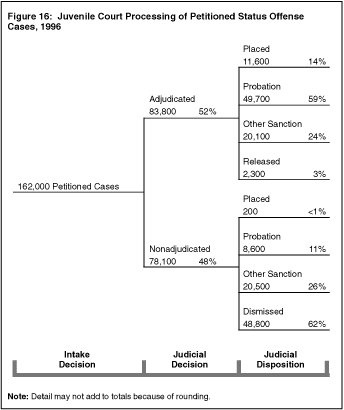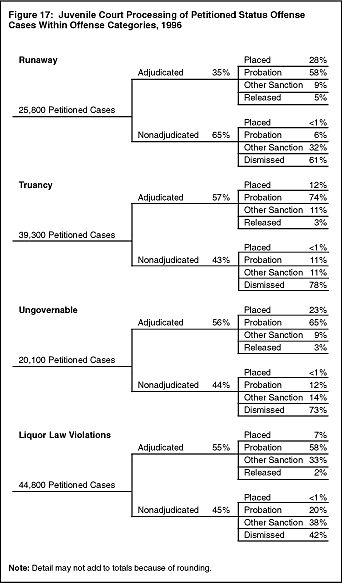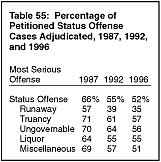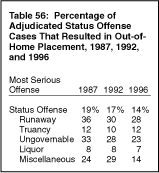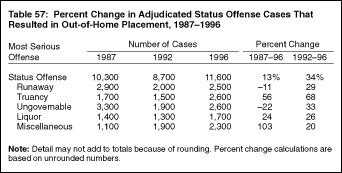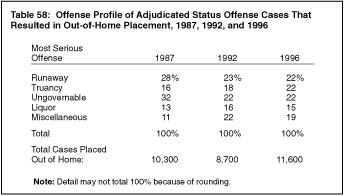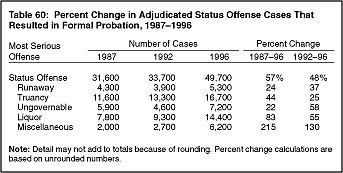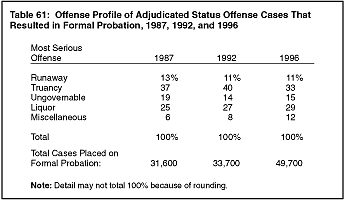|
Adjudication
In 1996, 52% of petitioned status offense cases handled by juvenile courts resulted in formal adjudication (figure 16).10 Ungovernability, truancy, and liquor law violation cases carried virtually the same likelihood of adjudication (figure 17). Proportionately fewer runaway cases were adjudicated. The proportion of petitioned status offense cases resulting in adjudication declined from 66% to 52% between 1987 and 1996 (table 55). The proportion of petitioned cases resulting in adjudication declined in each of the four major offense categories between 1987 and 1996.
Disposition
The majority (59%) of adjudicated status offense cases in 1996 resulted in probation. In 14% of adjudicated cases, the youth was placed outside the home in a residential facility. In 24% of cases, other dispositions resulted (including restitution or fines, participation in some form of community service, or enrollment in a nonresidential treatment or counseling program). A higher proportion of status offense cases than delinquency cases received a disposition of "other," possibly reflecting the use of counseling and treatment referrals for status cases involving liquor law violations. In a small number of status offense cases (3%), the youth was adjudicated but was released without further sanctions or consequenses.
Out-of-Home Placement. The dispositions used in adjudicated status offense cases varied according to the most serious offense involved in the case. Adjudicated cases involving charges of ungovernability or running away were the most likely to result in out-of-home placement in 1996 (table 56). Residential placement was far less common for adjudicated cases involving status liquor law violations or truancy. The likelihood of out-of-home placement for status offense cases in general decreased between 1987 and 1996 (from 19% to 14%). This drop stemmed from declines in the use of placement for runaway and ungovernable cases.
Despite the drop in the overall proportion of adjudicated cases resulting in out-of-home placement, the number of adjudicated status offense cases that resulted in out-of-home placement increased 13% between 1987 and 1996 (table 57). The number of truancy, liquor law, and miscellaneous cases resulting in out-of-home placement increased, but the number declined for ungovernable and runaway cases.
Of all formally handled status offense cases involving out-of-home placement in 1996, 22% were referred to court for running away, 22% for ungovernability, 22% for truancy, and 15% for status liquor law violations (table 58).
Formal Probation. In 1996, an order of formal probation was most likely in adjudicated truancy cases (74%) (table 59). Probation orders were less common among ungovernable cases (65%), liquor law violations (58%), and runaway cases (58%). Overall, the proportion of adjudicated status offense cases that resulted in formal probation increased between 1987 and 1992 (from 59% to 65%), and then decreased between 1992 and 1996, returning to the 1987 level.
Although the proportion of adjudicated cases ordered to probation was the same in 1996 as in 1987, the number of cases increased 57% (table 60). Liquor law violations accounted for the largest share of this increase. The number of formal probation cases increased 83% for liquor law cases, 44% for truancy cases, 24% for runaway cases, and 22% for ungovernability cases.
Although the 1996 offense profile for formal probation was similar to the 1987 profile, there were smaller proportions of status offense cases involving running away, truancy, and ungovernability and a larger proportion involving liquor law violations. In 1996, 33% of the adjudicated status offense cases that resulted in probation involved truancy as the most serious charge, 15% involved ungovernability, 11% involved running away, and 29% involved liquor law violations (table 61).
|
